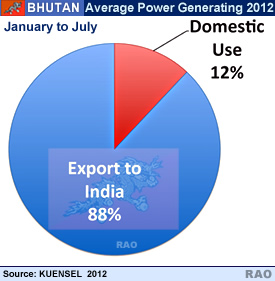 |
Bhutan's
Economy: Hydroelectric Power |
|
|
 |
|
Bhutan's hydropower generation 2012
|
 |
 |
|
Hydropower Bhutan's hydropower generation in July 2012 stood at 1,551 Megawatt (MW), most of which was exported to India, and is expected to earn a revenue of Rs 2B.
In June 2012, the total generation stood at 881 MW.
Druk Green Power corporation (DGPC) officials said generation would have been much higher, if the monsoon had started early.
Generation peaked only during mid July and, although rainfall was plenty, excess water had to be discharged, since most of the existing power plants do not have reservoir dams to store the water.
Most of the power plants are run-of-the-river schemes, which means they cannot store water, and make use of it during the dry season.
|
|
"Today, all the power plants are running full capacity," said a DGPC official.
Of the 1,551 MW, only around 12 percent was allocated for domestic use, with the rest exported to India.
Bhutan conducted a meter reading yesterday in the two stations linking the power grids of the two countries connect.
This will capture the exact amount of power that has been exported and imported between the two countries.
After that, the bills will be submitted to the Power Trading corporation of India.The official from DGPC said that the final payments would be made within 60 days from the date of submission of bills.
The peak season for Bhutan's electricity generation will continue until September.
The lean generation season starts from October to March.During this period, Bhutan had to import electricity worth Nu 30M last winter.
Domestic energy demand increases during the winter months for heating purposes, when the generation is at its lowest, and then begins to dip when generation picks up in the summer months.
The earning during peak season is expected to provide some respite to the persisting rupee shortage.Hydropower export to India is a major source of rupee for the economy.Hydropower earnings contribute more than 20 percent of overall revenue.
Major hydropower projects like theChukha (336 MW), Kurichhu (60 MW) and Tala (1029 MW) projects have all been built through Indian assistance.
Bhutan still pays its loans for Tala and Kurichhu while for Chhukha it has been cleared. last year the annual total hydropower earnings stood at around Rs 10B out of which Rs 3B was paid for the loans taken to build Tala and Kurichu.
Meanwhile the construction of Punatshangchhu I and II has begun and is expected to be completed at the end of 2016 and 2017. the construction of the 670 Megawatt Mangdechhu project in Trongsa also began last year. this year will see the construction of four joint venture projects which are Kholongchhu, Bunakha, Amochhu and Wangchu.
Sankosh, the country's biggest project with a capacity of 2,560 Megawatt will begin next year.
| Contributed
by Nidup Gyeltshen ,KUENSEL, Bhutan's National Newspaper, August 2012 |
 |
| Information on Bhutan |
 |
|



